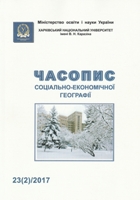Temporal features of the development of the cities of the Kharkov region
Abstract
Kharkiv region is one of the most developed regions of Ukraine. One of the main problems is the slowness of the territorial development of the population settlement system, the excessive concentration of population in the city of Kharkiv. The transition from monocentric to polycentric model of spatial regional development of the Kharkiv region is one of the priority directions of development. The practical realization of this task depends on the knowledge of the laws of the population movement of the cities of Kharkiv region. Analysis of the dynamics of the population of cities in the Kharkiv region and the population growth rate from 1992 to 2016 allowed grouping the cities of the region at the rate of population decline due to their population size.
Four groups have been formed with a slow pace of population decline (from -10% to -15%): Kharkiv, Chuguev - cities with a significant population, strong industrial development, with average population decline (from -15.1 % to -20%): Kupyansk, Balaklia, Bogodukhiv, Dergachi, Valki, South – industrial centers with significant potential for development, and where there are several production areas: construction materials industry, light industry, food industry, etc.
Cities with significant population declines (from -20.1% to -25%): Lozova, Izyum, Pervomaisky, Lyubotin, Vovchansk, Zmiyiv, Krasnograd, Merefa – peripheral district centers and cities of the Kharkiv agglomeration, where there is at present a decline in the rate of industrial production and, consequently, jobs. Izyum and Lozova's cities slowed down due to the proximity to the area of the anti-terrorist operation.
Among the cities of Kharkiv region Barvinckove has very high (more than - 25.1%) pace of population decline, which undoubtedly is a significant problem for the development of the entire settlement system, since such a rapid reduction can lead to the deprivation of the city Barvinkovo status of the city, the deepening of developmental imbalances "Center-periphery" and an obstacle to the polycentric development of the territory. It is important to have a balanced regional, demographic policy for cities belonging to groups with significant and high rates of population decline.
Downloads
References
2. Christaller, W. (1967). Central Places in Southern Germany. Englewood Cliffs, 230.
3. Golikov, A.P., Chervanyov, I.G. (1986). Matematychni metody v geografii [Mathematical methods in geography]. Kharkiv: publishing at Kharkov University, 143.
4. Dzhaman, V.O. (2003). Regionalni systemy rozselennya: demografichni aspekty [Regional settlement system: demographic aspects]. Chernivtsi: Ruta, 392.
5. Krul, V.P. (2000). Osoblyvosti vyvchennya protsesiv zaselennya ta osvoyennya terytorii istoryko-geografichnykh kraiv [Features studying the processes of settlement and development in historical and geographical territories]. Kyiv-Lutsk Tower, 2000, 372.
6. Lappo, G.M. (1997). Geografiya gorodov [Geography of cites]. Publishing Center for Humanities VLADOS, 480.
7. Lyosh, A. (1968). Prostorova organizatsiya gospodarstva [The spatial organization of the economy]. Science, 664.
8. Mista rayonnoho znachennya Ukrainy: problemy sotsialno-ekonomichnoho rozvytku [Cities of the regional significance of Ukraine: problems of socio-economic development]. Available at: http://www.google.ru/url?q=http://old.niss.gov.ua/book/Mista/5_51.pdf
9. Niemets, K.A., Kravchenko, K.O. (2016). Zmina roli mist Kharkivskoi oblasti – retrospektyvnyi analiz [The changing role of cities in the Kharkiv region – a retrospective analysis]. Visnyk of V.N. Karazin Kharkiv National University, Series “Geology. Geography. Ecology”, 44, 123-129.
10. Niemets, L.M., Niemets, K.A., Segida, K.Yu. (2012). Demografichnys rozvytok Kharkivskoho regionu [Demographic development of Kharkiv region]. Kharkiv, KhNU of V.N. Karazin, 200.
11. Ofitsiynyi sayt Holovnoho upravlinnya statystyky Kharkivskoi oblasti [Official website of the Main Statistical Office in Kharkiv region]. Available at: http://uprstat.kharkov.ukrtel.net
12. Strategiya rozvytku Kharkivskoi oblasti na period do 2020 roku [Strategy for the development of the Kharkiv region up to 2020]. Available at: kharkivoda.gov.ua/documents/16203/1088.pdf
Copyright (c) 2017 Катерина Кравченко

This work is licensed under a Creative Commons Attribution 4.0 International License.




